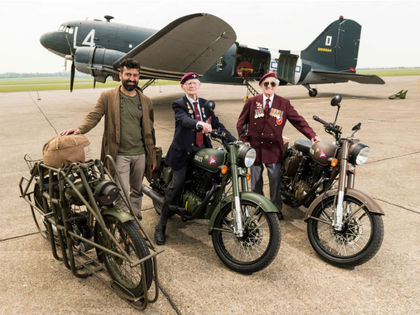5 Interesting Facts About Royal Enfield Classic 500 Pegasus
- by Praveen M
- May 24, 2018
- | Views: 10041
The story behind the recently-launched Classic 500 Pegasus goes way back into the throes of World War II. Here are five interesting facts about the famed motorcycle!

The history behind the bike’s inspiration:
Royal Enfield enjoys a rich and varied heritage in the field of arms and motorcycle manufacturing. The marque’s motto ‘Made Like a Gun - Since 1901’ is a true testament to this fact. Royal Enfield motorcycles were the British troops’ trusty companions in France and Belgium during the World War I. Even the Imperial Russian Army was a patron of Royal Enfield’s legendary motorcycles.
In World War II, tens of thousands of Enfield motorcycles were shipped to almost every theatre of conflict. The British bike maker played an important role in getting rid of WWII’s Nazi reign - which stood like a cancer to humanity, by supplying the airborne troops with its compact yet highly capable motorcycle, the ‘Flying Flea’. The Royal Enfield Classic 500 Pegasus was conceived as a tribute to this revered motorcycle. The Flying Flea shone like a light of hope in the arena of war thanks to its adaptive design whose details are revealed in the forthcoming paragraphs.
The legend of the Flying Flea:
Royal Enfield says the Flying Flea was the only proper motorcycle that could be dropped successfully behind enemy lines with paratroopers. Impressed with its capabilities, the United Kingdom’s War Department ordered more than 4,000 units of the Flea. The motorcycle was deployed in two ways - either dropped by parachute in a protective steel cradle or carried aboard the Airspeed Horsa assault gliders. On the ground, it was used for reconnaissance, communications and carrying soldiers into battle.
In September 1944, Allied forces conducted an ambitious tactical ploy called ‘Operation Market Garden’. They tried to enter Germany from Holland through a series of captured bridges, and it culminated in the Battle of Arnhem. Outgunned, outclassed and outnumbered, the paratroopers endured against the might of German tanks for an incredible seven days! Plagued with predicaments like broken radio sets, commanders relied on the Flying Flea to deliver messages. The 3.5PS from its puny 125cc two-stroke engine may not sound like much. But in a life and death scenario, or worse, capture, having such a sturdy yet lightweight companion by your side proved to be a boon. Thanks to its wet weight of just 59kg, it could be carried over difficult terrains!
War veteran and motorcycle enthusiast John Jeffries, who parachuted into Holland with the 4th Parachute Brigade, recalls, “Despatch riders went to headquarters at Oosterbeek Town Hall from the detachments. They used to be buzzing around from all over. I liked that motorcycle. They were a lovely size. I always judged a motorcycle by its weight and the Royal Enfield was just my type.”
The Flying Flea also played a vital role on the windy day (read D-Day) of 6 June 1944 in Normandy, Northern France, where the allies conducted the largest amphibious invasion in history. Hundreds of Flying Fleas and James ML motorcycles were deployed, streaming from landing crafts on to the beaches, escorting the brave soldiers into their pyrrhic victory.
The design of the Pegasus:
The Royal Enfield Classic 500 Pegasus is based on the already-existing Classic 500 motorcycle. The limited-edition motorcycle comes with a bespoke set of military-style canvas panniers bearing the Pegasus logo. Royal Enfield has left no stone unturned to make the bike as authentic as the famed military motorcycle, with the inclusion of brown handlebar grips, a leather strap with brass buckles across the air filter, blacked out exhaust, rims, kickstart, pedals and headlight bezel to complete the period look. The Pegasus emblem, which is the official insignia of the Parachute Regiment proudly adorns the fuel tank along with an individually stencilled serial number. The famous Royal Enfield ‘Made Like a Gun’ decal on the battery box is another reminder of the machine’s heritage.
In addition, consumers can also buy a range of genuine motorcycle accessories that are compatible with the motorcycle. The limited-production apparels and accessories inclusive of the dedicated Pegasus-inspired merchandise like shirts, t-shirts, caps, lapel pins, bags and helmets, will also be available soon.
Specifications:
Coming to the numbers, the bike has the same underpinnings as the standard model. The 499cc, air-cooled, fuel-injected single-cylinder thumper punches out 27.5PS at 5250rpm, with 41.3Nm of torque generated at 4000rpm. A 5-speed transmission sends power to the rear via a chain drive.
The motorcycle rides on 35mm front telescopic forks and twin rear gas-charged shock absorbers. The UK-spec model gets a dual-channel ABS to rein the 280mm front and 240mm rear disc. The Pegasus is a single seater, and the fuel tank can hold 13.5 litres of juice.
Availability and Pricing:
The Royal Enfield Classic 500 Pegasus is limited to 1,000 units worldwide, with 250 units allotted for India. Internationally, the motorcycle is available in two colour options: Service Brown and Olive Drab Green. However, only the former is available for the Indian market. In the UK, the bookings will commence online from July onwards.
In the UK market, the motorcycle costs GBP 4,999 (approximately Rs 4.5 lakh) on-road. This makes the bike GBP 300 (around Rs 27,300) more expensive than the regular Classic 500. Expect the India-spec version to bear a similar premium over the standard version of the Classic 500, which costs Rs 1.68 lakhs (ex-showroom Delhi). Though the premium is a tad heavy and the bike is nowhere as light as its ancestor, it gives Royal Enfield enthusiasts a chance to own a piece of momentous motorcycle history. You can’t put a price on glory, can you?
